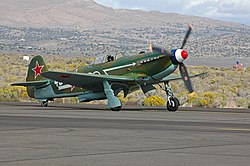Yakovlev Yak-9
| Yakovlev Yak-9 | |
|---|---|

|
|
| Type: | Fighter plane |
| Design country: | |
| Manufacturer: | |
| First flight: |
1942 |
| Commissioning: |
1942 |
| Production time: |
1942 to 1948 |
| Number of pieces: |
16,769 |
The Jakowlew Jak-9 ( Russian Яковлев Як-9 ) is a Soviet- made fighter aircraft . It was developed during World War II and manufactured well into the post-war period. The NATO code name of the single - engine low - wing aircraft was Frank .
development
The first flight took place in the summer of 1942 as the successor to the Jakowlew Jak-1 and production variant of the Jakowlew Jak-7DI with a Klimow M-105PF . The troops were introduced in October 1942. 459 machines of this basic version were produced in the GAS-153 and GAS-166 plants. Either the WK-105PF or the WK-105PF 2 was used as the engine. The first use took place in December 1942 at Stalingrad .
In November 1942 a Jak-7 was modified to further increase its performance. It was named Jak-9 / M-106. Improvements related to the cockpit canopy, the now fully retractable tail wheel and the aerodynamics. The M-106 engine , however, turned out to be immature.
During the Second World War, 14 different model variants were produced in large series. The two-seater Jak-9UTI was developed for training purposes, which was equipped with an elongated fuselage, a split cabin and a double control system. In addition to being used for training purposes, the Jak-9UTI was also used for courier flights. In addition, there were a number of experiments. 14,514 copies were built during the war.
In the post-war years, another 2,245 machines were produced, of which 801 were series machines of the post-war version Jak-9P, which were delivered from January 1948 to December 1948. They were used in Albania, China, Hungary, Yugoslavia, North Korea and Poland, among others.
commitment
The Jak-9 was the most widely used fighter by the Soviet Air Force during World War II. It was used as an escort, interceptor and long-range fighter, fighter-bomber and attack aircraft for fighting tanks. Their use contributed to the air superiority over the German air force . During the Korean War , a Yak-9 of the North Korean armed forces shot down a B-29 for the first time on July 12, 1950 over Seoul .
Users
- People's Liberation Army : 16 Jak-9T, 40 Jak-9P, 47 Jak-9D / M and 68 Jak-9U
Technical specifications
| Parameter | Jak-9U | Jak-9P | Jak-9PD |
|---|---|---|---|
| span | 9.77 m | 9.74 m | |
| length | 8.55 m | ||
| height | 2.44 m | 3.19 m | k. A. |
| Wing area | 17.25 m² | 17.15 m² | |
| Empty mass | 2,575 kg | 2,716 kg | 2,600 kg |
| Takeoff mass | normal 3,098 kg | 3,393 kg | k. A. |
| Engine | a V12 piston engine Klimow WK-107A | a V12 piston engine Klimow WK-105PD | |
| power | 1,173 kW (1,595 hp) | 1,182 kW (1,607 hp) | k. A. |
| Top speed | 700 km / h at an altitude of 5,000 m | 673 km / h at an altitude of 5,700 m | 610 km / h |
| Rise time | 4.1 min at an altitude of 5,000 m | 5.8 minutes at an altitude of 5,000 m | ? |
| Summit height | 11,900 m | 12,060 m | 14,500 m |
| Range | 870 km | 935 km | 550 km |
| Armament | one 20-mm-MK SchWAK two 12.7-mm-MG UBS two 100-kg bombs external |
one 20 mm MK SchWAK two 12.7 mm MG UBS |
a 12.7 mm MG UBS and a 7.62 mm MG SchKAS |
See also
literature
- Olaf Groehler : History of the Air War 1910 to 1980 . Military publishing house of the German Democratic Republic, Berlin 1981.
- Bill Gunston: The Osprey Encyclopedia of Russian Aircraft. Osprey, London 2000, ISBN 1-84176-096-X .
- Вадим Борисович Шавров : История конструкций самолетов в СССР, 1938–1950. Машиностроение, Москва 2002, ISBN 5-217-03103-4 .
Web links
Individual evidence
- ↑ cf. Olaf Groehler: History of the Air War 1910 to 1980 , Military Publishing House of the German Democratic Republic, Berlin 1981, p. 346.
- ↑ According to Olaf Groehler: History of the Air War 1910 to 1980 , Military Publishing House of the German Democratic Republic, Berlin 1981, p. 346, 17,000 units were built during the war.
- ↑ Bojan Dimitrijevic: Yugoslav Air Force 1942–1992. Belgrade 2006.
- ↑ a b Fliegerrevue 6/1986, p. 191.
